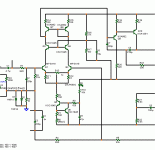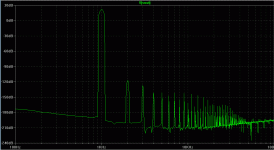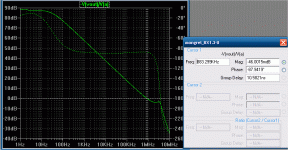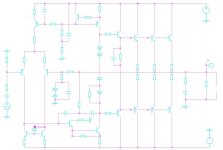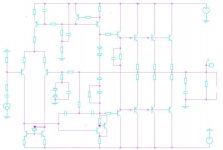Transitional miller comp??
I thought of something along those lines about 10 years ago - with a resistor from the output feeding a junction between 2 miller comp caps. The VAS was a high beta CFP type and I implemented it in a preamp. However, I struggled to hear any audible improvement - but then again it was a class A preamp. Perhaps it's worth revisiting within a class AB power amp? Those sims look good and I'm surprised that the 10kHz plot looks so good too. I wonder though if there are limitations when driving real world speakers. Those sims I gather were with a 8+j0 load??
OK, I just found a reference in Bob's bible. Page 182.
Transitional miller comp??
I thought of something along those lines about 10 years ago - with a resistor from the output feeding a junction between 2 miller comp caps. The VAS was a high beta CFP type and I implemented it in a preamp. However, I struggled to hear any audible improvement - but then again it was a class A preamp. Perhaps it's worth revisiting within a class AB power amp? Those sims look good and I'm surprised that the 10kHz plot looks so good too. I wonder though if there are limitations when driving real world speakers. Those sims I gather were with a 8+j0 load??
Yes, that is this kind of comp.
As demonstrated by Edmond, TMC does mainly reduce THD of the OPS,
so with your preamp it s logical that it didn t bring a lot since
a preamp OS is generaly lightly loaded and produce few distorsions.
You are right, the simed load was purely resistive, but it would
have worked as well in a partly reactive load.
Yes, that is this kind of comp.
As demonstrated by Edmond, TMC does mainly reduce THD of the OPS,
so with your preamp it s logical that it didn t bring a lot since
a preamp OS is generaly lightly loaded and produce few distorsions.
You are right, the simed load was purely resistive, but it would
have worked as well in a partly reactive load.
I will try TMC with this 'blameless' design.
Rather than go all out TMC, I might use a small amount of pure miller comp
(33pf) and then add 47pf worth of TMC.
(c1=56pf, c2= 220pf, R1 = 3K3), transistion frequency = 220kHz.)
Last edited:
I will try TMC with this 'blameless' design.
Rather than go all out TMC, I might use a small amount of pure miller comp
(33pf) and then add 47pf worth of TMC.
(c1=56pf, c2= 220pf, R1 = 3K3), transistion frequency = 220kHz.)
If a "straight blameless" does as a bootstrap current sourced blameless does , the ULD should easily do 10-20ppm at 50w/1k w/TMC. The steady fixed current source will outdo the bootstrap in THD , but not in listenability. With a panasonic EE low esr cap the 2 amps are within 3-4ppm in simulation. 🙂
I use 100p/270p with a 470R TMC feedback resistor , this matches my bode plot for a 47p traditional miller SM cap.
OS
I will try TMC with this 'blameless' design.
Rather than go all out TMC, I might use a small amount of pure miller comp
(33pf) and then add 47pf worth of TMC.
(c1=56pf, c2= 220pf, R1 = 3K3), transistion frequency = 220kHz.)
Increasing the resistor, the compensation converge
to a classical miller comp.
I simulated with a 100pf/220pf/1K network..
Attachments
Increasing the resistor, the compensation converge
to a classical miller comp.
I simulated with a 100pf/220pf/1K network..
If you have some spare time it would be interesting to SIM the effect of employing the gain reduction method outlined by Self:- series RC in parallel with the miller comp, but taken from the OPS rather than VAS.
Perhaps starting values could be 820pf + 330K.
Obviously this would only be effective at reducing LF and MF distortion. It would need to be implemented with TMC to be effective at HF.
Last edited:
At this level of excellence, the sims tell you little of the sound quality. You really have to build and compare, I'm with Pete on this. My experience of TMC is that the improvement in SQ is marginal, but that's not to say it should not be done, since there may be stability enhancements with the OPS included in the loop compensation. This might bring real benefits with difficult loads like ESL speakers.
Hugh
Hugh
At this level of excellence, the sims tell you little of the sound quality. You really have to build and compare, I'm with Pete on this. My experience of TMC is that the improvement in SQ is marginal, but that's not to say it should not be done, since there may be stability enhancements with the OPS included in the loop compensation. This might bring real benefits with difficult loads like ESL speakers.
Hugh
Hugh, I would think the opposite wrt stability into xc loads. The benefits would be more related to low impedance / low reactive loads.
The partial inclusion of the OPS within the VAS miller loop will cause the VAS to generate some OPS pre distortion. This seems to be a very elegant solution when compared with dedicated error correction add-ons. But only if you're an advocate of miller compensation.
David (?)
I cannot comment on your views; frankly, I do not know. But the subjective aspects (cf. listening tests with a variety of loads, particularly lo Z) would tell us if THC is the best option......
Hugh
I cannot comment on your views; frankly, I do not know. But the subjective aspects (cf. listening tests with a variety of loads, particularly lo Z) would tell us if THC is the best option......
Hugh
David (?)
But the subjective aspects (cf. listening tests with a variety of loads, particularly lo Z) would tell us if THC is the best option......
Hugh
Hugh,
If I used THC I would definitely want the smoke to come out🙂
Ah, yes, tetrahydrocannanibol, no less?
A dry but joyful typo, huh?
Nonetheless, I will hold to my view that THC is useful in any subjective assessment of the efficacy of TMC.
You mischievous hippy, you.....
Hugh
A dry but joyful typo, huh?
Nonetheless, I will hold to my view that THC is useful in any subjective assessment of the efficacy of TMC.
You mischievous hippy, you.....
Hugh
As you might or might not know , I jumped on E. stuart's TMC implementation with the blameless. I had 2 pair of blameless modules (AX,BX- below). I ascertained that it WAS working on the actual module(s) as I was able to even grossly underbias before the onset of audible Xover distortion. subjectively , I will say my search for the best sounding amp is over (pix 2- FFT) , it is below. Carlos (DX) came close (blame ES-ST), but I like low noise inputs and gobs of power at under 200ppm (below 3 - amps).
I also TMC'ed the AX , which for all purposes is a ULD voltage stage. It sounded wonderful if not sterile. The 2 gold panasonic EE's (front- pix 3) do actually give life to the sound , hard to believe with a amp that does 12ppm at 50w/1k. 😕 As I might of stated before ,100/270p with a 390R TMC feedback cap gives exactly the 875KHZ UG point as a conventional miller of 47p (pix4 - BODE). Clipping errata is the same (tested on my 40v rail setup - bx1.3) , I now move past the prototype , on to the good sound. 🙂
BTW , THC was instrumental in incorporating TMC on this side of the pond. 😀
OS
I also TMC'ed the AX , which for all purposes is a ULD voltage stage. It sounded wonderful if not sterile. The 2 gold panasonic EE's (front- pix 3) do actually give life to the sound , hard to believe with a amp that does 12ppm at 50w/1k. 😕 As I might of stated before ,100/270p with a 390R TMC feedback cap gives exactly the 875KHZ UG point as a conventional miller of 47p (pix4 - BODE). Clipping errata is the same (tested on my 40v rail setup - bx1.3) , I now move past the prototype , on to the good sound. 🙂
BTW , THC was instrumental in incorporating TMC on this side of the pond. 😀
OS
Attachments
Last edited:
Pete,
Could it be that your journey has reached the end of the blacktop?
Hugh
When the amps fidelity equals the source , where can you go ?? I think it's time for some line level "magic" (preamps). Maybe a softly glowing buffered vacuum tube mellowing the DAC output running these beastly amps.
Just curious , Hugh.... was something akin to TMC (nested feedback)... the "secret" (yours) , for it (TMC) seems to have brought these amps to a whole new level (listenability as well 🙂 )
OS
When the amps fidelity equals the source , where can you go ?? I think it's time for some line level "magic" (preamps). Maybe a softly glowing buffered vacuum tube mellowing the DAC output running these beastly amps.
I believe you've reached the end of the engineering, and the beginning of the psychoacoustics, whatever that might be. I agree about a tube. If you want magic, I can't think of a better approach than a tube. A bit like the advertising industry, messing with the mind?
Just curious , Hugh.... was something akin to TMC (nested feedback)... the "secret" (yours) , for it (TMC) seems to have brought these amps to a whole new level (listenability as well )
OS
Yes, something like this - nested feedback and phase lead. With TMC you are 'nesting' the compensation regime, so there are analogies.
Warm congratulations, Pete,
Hugh
This kind of power amplifier has reached the best possible performance in my opinion.
You may have very small differences with further improvements...these amplifiers are all Blameless style...all them sounds awsome!
I do think Hugh did some pre amplifiers that may increase the quality, Ostry was kidding maybe, but have detected the way to increase... as we love tube harmonics.
Please, take a look at this video.... as one of these Blames..... VAS feeded by a bootstrapp under a genuine Hugh Dean old style approach...an Aikido pre amplifier matched in a lovely way.
Connect a good amplifier and speaker to your PC and listen it loud.... observe the quality.... try to imagine the real thing playing...this was recorded using a NOKIA CELL PHONE!..observe the guy's voice is anything special..so...the audio recorder is not very good...even this way listen!... travell with these sound waves.... join uncle Charlie at the Paradise!
This was the best performance i could listen with that amplifier... despite acoustic problems... feel the magic folks!
YouTube - MY DIY STEREO, DX BLAME ST, AIKIDO
It is alike a Hayabusa motorcicle....you can match...but not outperform.
Please, switch Youtube's flash player to 480 lines....i found this increases treble.
I have to thank Hugh Dean once again...if he had teached me that simulators just point us numbers.... that audition, listening tests are much more important, that numbers does not mean always audio quality..that they are just a reference.....without these ideas i would never had courage to tweak the Blameless and to obtain this kind of result..... i have found the best to my ears.... anything more interests me about power amplifiers.... not possible to beat absolute transparency.... now it is preamplifier, speakers, audio source and so on to research.
Others amplifiers?.... Doctor Self Blameless style amplifier can eat them all!
regards,
Carlos
You may have very small differences with further improvements...these amplifiers are all Blameless style...all them sounds awsome!
I do think Hugh did some pre amplifiers that may increase the quality, Ostry was kidding maybe, but have detected the way to increase... as we love tube harmonics.
Please, take a look at this video.... as one of these Blames..... VAS feeded by a bootstrapp under a genuine Hugh Dean old style approach...an Aikido pre amplifier matched in a lovely way.
Connect a good amplifier and speaker to your PC and listen it loud.... observe the quality.... try to imagine the real thing playing...this was recorded using a NOKIA CELL PHONE!..observe the guy's voice is anything special..so...the audio recorder is not very good...even this way listen!... travell with these sound waves.... join uncle Charlie at the Paradise!
This was the best performance i could listen with that amplifier... despite acoustic problems... feel the magic folks!
YouTube - MY DIY STEREO, DX BLAME ST, AIKIDO
It is alike a Hayabusa motorcicle....you can match...but not outperform.
Please, switch Youtube's flash player to 480 lines....i found this increases treble.
I have to thank Hugh Dean once again...if he had teached me that simulators just point us numbers.... that audition, listening tests are much more important, that numbers does not mean always audio quality..that they are just a reference.....without these ideas i would never had courage to tweak the Blameless and to obtain this kind of result..... i have found the best to my ears.... anything more interests me about power amplifiers.... not possible to beat absolute transparency.... now it is preamplifier, speakers, audio source and so on to research.
Others amplifiers?.... Doctor Self Blameless style amplifier can eat them all!
regards,
Carlos
Attachments
Last edited:
I believe you've reached the end of the engineering, and the beginning of the psychoacoustics, whatever that might be. I agree about a tube. If you want magic, I can't think of a better approach than a tube. A bit like the advertising industry, messing with the mind?
Yes, something like this - nested feedback and phase lead. With TMC you are 'nesting' the compensation regime, so there are analogies.
Warm congratulations, Pete,
Hugh
Speaking of tubes , another voltage controlled device .. an FET , will actually increase the second harmonic by 10db. With the BX / cascode arrangement I can sub sk170's or even matched mil spec. pairs. I am running total BJT / 90db OLG at the moment , the FET's drop that by 10db. So , crazy as it may sound , I might "swap" a couple hundred PPM for some added FET distortion. Just to see the effects on "psychoacoustics" (I do believe - MP3's are psychoacoustic in nature)... I'll think I'll skip the THC this time... 😀
OS
VHF man,
Please post your revised schematic.
I modified the Ostripper schematic.
The first schematic is what I'm using now and the second (alt2) is the next (preferred) variation.
Variations include TMC, a diode in the CM and VAS degeneration.
I prefer the CFP VAS. It sounds better and avoids the bias problems that the darlington can introduce.
FWIW, the amp sounds fantastic. Much better than any commercial class AB amp I have ever heard and miles ahead of a Meridian 557 that I use as a reference.
Attachments
FWIW, the amp sounds fantastic. Much better than any commercial class AB amp I have ever heard and miles ahead of a Meridian 557 that I use as a reference.
Hmm..that is indeed high praise. I might have suggested trying to organise large scale production somewhere before posting on Forum with that kind of result. 😀😀😀
Thanks nonetheless, it continues some interesting changes to the current stagnation of ideas and directions here in the ss forum. I hope it goes well as it develops. 😎
- Status
- Not open for further replies.
- Home
- Amplifiers
- Solid State
- New Amplifier - ULD Extreme
